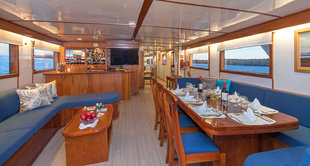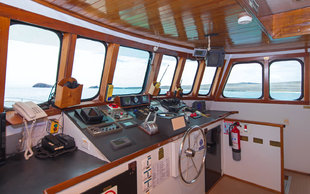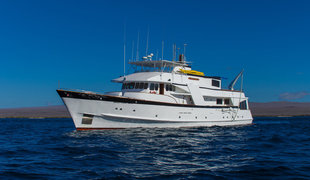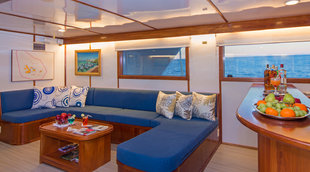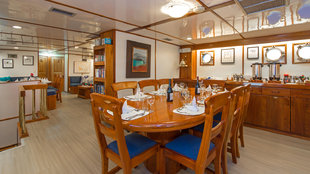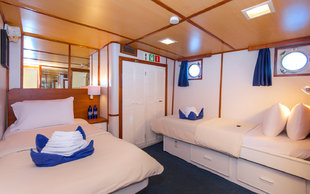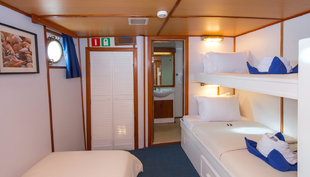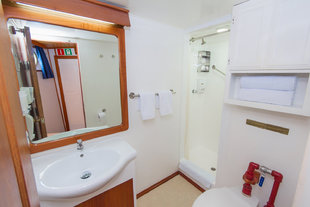Beluga is a splendid steel-hulled motor yacht, originally built in Hamburg, Germany in 1968. She was completely refurbished in 1986, transforming her into an elegant cruising vessel. With her large spacious decks and sleek modern design, Beluga is a fantastic way to explore the Galapagos Islands in style and at speed.

She can accommodate up to sixteen passengers in eight beautifully decorated double cabins. Each cabin is fully equipped with air-conditioning and its own private ensuite facilities. A useful consideration for mixed groups and families is that her cabins are a mix of twins and doubles. Another consideration is that her capacity of 13 is also smaller than most other vessels in the Galapagos, for which 16 is usually the smallest group size.
Guests can relax on her sundecks or unwind by the bar in the comfort of salon. The panoramic windows in the salon/dining area provide an excellent vantage point from which to do a spot of whale and dolphin watching. The crew onboard are friendly and attentive, serving up Ecuadorian specialities and continental cuisine in a cosy and informal dining area.
Beluga has all the facilities of a modern cruising vessel, but still manages to maintain her classic appeal.
| Cabin | Size | Window type |
| 1 | 2.77 m x 2.82 m | Porthole |
| 2 | 1.92 m x 2.97 m | Porthole |
| 3 | 2.44 m x 2.62 m | Porthole |
| 4 | 2.33 m x 3.60 m | Porthole |
| 5 | 2.38 m x 3.50 m | Porthole |
| 6 | 3.03 m x 2.43 m | Large panoramic |
| 7 | 3.03 m x 2.43 m | Large panoramic |
| 8 | 2.25 m x 4.65 m | Large panoramic |
Wildlife & Photography
The main focus of this trip is to experience the Galapagos’ unique wildlife and landscapes above, on and below the water. All itineraries include activities like hiking, kayaking, snorkelling, panga rides and swimming on excursions which take place twice daily, helping to give you the opportunity to explore the archipelago from different perspectives.
Each of the islands provides its own individual environment due to their age differences and stages of colonisation, which can differ by millions of years. As you make your way through any of the itineraries here, you will notice gradual changes in the landscapes and wildlife which you are surrounded by. Some of the wildlife which you can hope to see here includes Galapagos Sea Lions, Marine and Land Iguanas, Nazca and Blue-Footed Boobies, Galapagos Tortoises, Galapagos Penguins and Flightless Cormorants, among many others.
The great abundance and variety of life here makes this trip ideal for photographers. There are plenty of opportunities for every photographer to get their shots – macros of sunbathing Marine Iguanas, wide-angles of Sea Lion colonies and the islands and underwater captures of Sharks and Rays are just some of the possibilities here.
Even though the trips offered here explore a lot of the archipelago’s wonders, there are many other ways which you can explore the Galapagos Islands. If you wanted to extend your stay here to experience more of this location, you could book an add-on experience, such as a dive liveaboard from our Galapagos Dive Liveaboards page or one from our Galapagos page. We also offer trips in mainland Ecuador which you could choose to experience too.
Technical Specifications
| Category: | Superior First Class |
| Capacity: | 16 passengers |
| Length: | 110 ft |
| Beam: | 23 ft |
| Cruise Range: | 12 knots cruising |
| Type: | Motor Vessel, Steel hull |
| Mechanical Equipment: | Twin Scania Diesel Electronic 450 HP each, 3 Perkins generators for 110v and 220v, 2 reverse osmosis water makers, auto pilot system, sewage treatment plant |
| Safety Equipment: | VHF (DSC) & HF (DSC) radios. EPIRB, SART, satellite tracking device, 2 GPS’s, 2 radars, depth sounder, flares, basic first aid kits, 2 tenders with outboards, fin keels for extra stability, flotation rings, life rafts with surplus capacity for all passengers and crew, fire alarm system. |
| Guest Accommodation: | 8 Double cabins each with private bath. Hot / cold water showers. Security safe in each cabin |
| Crew: | All crew are fully trained and certified. Captain, multilingual naturalist guide, cook, 2 engineers, barman, and 4 sailors |
Itinerary
Please note that these itineraries are subject to change without notice due to seasonal changes, last minute weather conditions and the decision of the Galapagos National Park authority.
Day 1 (Wednesday) – Arrival & Highlands / Darwin Station
AM: Arrival, Baltra Island
Upon arrival Baltra, travellers pass through an airport inspection point to make sure that no foreign plants or animals are introduced to the islands, and to pay the park entrance fee of $200 (unless it has been prepaid). A guide will meet you, help you collect your luggage and escort you on a short bus ride to the harbour.
PM: Highlands / Twin Craters & Charles Darwin Research Station, Santa Cruz Island
The road to the highlands leaves from Bellavista, a small village located a 15-minute drive from Santa Cruz’ main town of Puerto Ayora. The road passes through the Galapagos’ most productive agricultural zone, up to the National Park boundary. We find Miconia vegetation at this altitude, changing to the Fern and Sedge zone as we ascend further. With clear weather, we can enjoy beautiful scenes of rolling hills and extinct volcanic cones covered with grass and lush greenery all year round. In the Highlands is El Chato Reserve, where Giant Galapagos Tortoises can be observed in the wild – the iconic species which gave the Galapagos Islands their name. Other species to see at this reserve include Short-Eared Owls, Yellow Warblers & Finches. More elusive species which can be difficult to spot here are Galapagos Rails & Paint-Billed Crakes.
The Twin Craters are 2 large sinkholes formed by the collapse of rock over a lava tube. The fertile volcanic soils here have made the Twin Craters heavily vegetated, in turn supporting lots of birdlife. Common sightings in the area include Vermillion Flycatchers, Short-Eared Owls & the Galapagos Dove.
Although the great majority of Galapagos visitors come to the Charles Darwin Research Centre to observe and appreciate natural wonders, it is also interesting to learn how the protection and conservation of the islands are carried out. The main attractions are the National Park information centre, the Van Staelen Exhibition Hall, the Breeding and Rearing Centre for young tortoises, and adult Galapagos tortoises in captivity.
Day 2 (Thursday) – Chinese Hat & Rábida
AM: Sombrero Chino
Chinese Hat, aptly named due to its slowly sloping sides giving the island an appearance resembling that of a Chinese hat, is one of the smallest in the peninsula. The recent formation of the island gives it a unique environment where there are different stages of colonisation by pioneer species at this location compared to others you will have visited. Walking on the island is a great way to experience the island’s wildlife, including Sally Lightfoot Crabs, Marine Iguanas, Galapagos Sea Lions & Lava Lizards. Out of the cracks in dried-up lava, lava cacti are a common sight. The waters of the island are calm & home to White-Tip Reef Sharks, so there is ample opportunity for snorkelling & kayaking here too.
PM: Rábida Island
Rábida Island is unique because of the red colour of the rocks and sand. The volcanic material on this island is very porous and external factors such as rain, saltwater and sea breeze have acted as an oxidising agent. A short walk along a trail leads us to a coastal lagoon behind the beach where we can see land birds including finches, doves, yellow warblers and mockingbirds; seabirds such as pelicans, masked and blue-footed boobies; and of non-feathered species you can hope to see marine iguanas and sealions. Our team will take you to a small brackish lagoon where you can anticipate a colony of flamingos.
Day 3 (Friday) – Sierra Negra & Villamil Port
AM: Sierra Negra Volcano, Isabela Island
Of volcanic scenery, southern Isabela is home to a volcanic crater second only in scale to Tanzania's Ngorongoro Crater. Volcan Sierra Negra is 6 miles (10 km) across! To reach the closest point of the crater edge involves an overland drive and then a between 45 mins to 1 ½ hour hill walk. On a dry sunny day this can be relatively easy. When cloud comes in and there is rain, we have to pick our way more carefully. The summit can often be seen from the southern coast, but on days when cloud obscures a view, we can trek above this layer for clear views across the crater – if not at first then certainly as we trek east along the crater edge where the climate is drier. When you reach the crater edge, the scale of the landscape is difficult to absorb.
The ultimate aim is to trek along the crater edge to Cerro Chico. This parasitic cone erupted spectacularly in 2005, just when the BBC were filming a series called Islands that Changed the World. Just beneath the surface, the rocks can be very hot, with lava tunnels running in all directions. It is essential to stick to marked trails here, because apparently solid rock can be very thin, with large voids beneath. The stark scenery here is a beautiful mix of shades and contrast between vegetation and bare dried contorted lava. Views from Cerro Chico extend far north to the enormous Elizabeth Bay and Fernandina Island.
PM: Puerto Villamil, Isabela Island
Puerto Villamil is a port village in southeast Isabela and is the Galapagos’ westernmost settlement. In this village is a modern church, Iglesia Cristo Salvador, which is found in the centre of the town and has a wall of paintings of the animals typically seen on the island. Also in the village is a boardwalk, located in the southeast of the town, which passes through mangroves in saltwater lagoons where is it possible to see Flamingo, Black-Winged Stilts and other waders searching for Shrimp.
Day 4 (Saturday) – Moreno Point & Elizabeth Bay
AM: Punta Moreno, Isabela Island
Punta Moreno is the site of a large dry lava field created by Cero Azul Volcano. This is a strange landscape, with vegetation-less lava, tidal lagoons and mangroves all in the same space. In some of the large tidal lagoons and pools, you may be able to see Green Turtles and Sharks. The mangrove forests provide habitat for other animals like Galapagos Flamingos, Brown Pelicans and some Galapagos Penguins.
PM: Elizabeth Bay, Isabela Island
This is a marine visitor site, so the excursion has no landing point. Your panga ride starts with a visit to the Marielas islets: home to the largest and most important penguin colony in the Galapagos Islands. The excursion continues into a cove, surrounded by red mangroves, where you can admire their red roots and green leaves. Here, you might be able to observe sea turtles, flightless cormorants, spotted eagle rays, golden cownose rays, brown pelicans and sealions. You might also see Galapagos hawks soaring overhead with schools of pompano and dorado fish swimming down below.
Day 5 (Sunday) – Urbina Bay & Tagus Cove
AM: Urbina Bay, Isabela Island
Urbina Bay is on the west coast of Isabela and has a recently uplifted seabed which has forced corals up above the water’s surface, providing a unique snorkelling experience. There are 2 treks at this bay which offer chances of seeing Galapagos Tortoises & large Land Iguanas amongst other wildlife including Flycatchers, Finches & Mockingbirds.
PM: Tagus Cove, Isabela Island
A tour along the cliffs will give visitors a good chance to see the Galapagos penguin, the flightless cormorant and other seabirds. From the landing dock, it is about a 30-minute hike along the trail up to the top of the cliff from where you can view Darwin Lake, an uplifted lake saltier than the sea. You can also see several volcanoes from this location. Look carefully at the graffiti on the surrounding cliffs of the cove, done by pirates, whalers and buccaneers in past centuries!
Day 6 (Monday) – Espinosa Point & Vicente Roca Point
AM: Punta Espinoza, Fernandina Island
Fernandina is the third largest island in the archipelago and has a single visitor site: Punta Espinoza, located at the northeastern tip of the island. Here, marine iguanas conglomerate in larger groups than on any other island. They bask around in the sand, swim near the shore and sometimes block the way at the landing dock. Among the unique species found here, we can find the flightless cormorant.
PM: Punta Vicente Roca, Isabela Island
There are great snorkelling opportunities at Vicente Roca Point thanks to upwelling cold-water currents here. Marine life in the area includes various Shark species, Galapagos Penguins, Seahorses & Mola-Mola. Other animals which you can hope to see here are Nazca & Blue-Footed Boobies, Brown Pelicans & Flightless Cormorants.
Day 7 (Tuesday) – Espumilla Beach / Buccaneer’s Cove & Bartolomé
AM: Espumilla Beach & Buccaneer’s Cove, Santiago Island
Espumilla Beach is an important breeding site for turtles. It suffered for a period, from feral pigs which dug up turtle nests; but the beach’ natural state has been restored so the turtles return year after year to bury their eggs into the cinnamon-coloured sand dunes. 6 weeks later, during the months of February to August, the eggs hatch.
The beach ridge hides a mangle with two lagoons on the backside. A colony of American flamingos and aquatic birds used to be its main attraction, but after a previous El Niño, strong sedimentation altered the water environment, and now no longer provides their food. Vegetation zones are very close by, providing great scenic contrasts. During the climb up a hill, you will be rewarded with a beautiful view of the transitions from sea to beach and from mangrove to a dry palo santo forest.
At the nearby Buccaneers Cove, you will have the opportunity to snorkel amongst Galapagos marine life.
PM: Bartolomé Island
One of the Galapagos’ most iconic locations, the beautiful volcanic islet of Bartolomé is among the youngest islands in the archipelago. On a geological scale Bartolomé was only recently born out of volcanic activity. Although at first sight lifeless, Bartolomé offers some of the wildest landscapes and best panoramas of the entire archipelago. To enjoy the postcard view of the idyllic Pinnacle Bay, you have to climb steps to a viewpoint on top of the island (114m / 375ft). Enter a dramatic world of threatening (though extinguished) nearby spatter cones, craters, and lightweight lava droplets that have been spewed out by fiery fountains. The Summit Trail is also ideal for witnessing how scanty pioneer vegetation such as lava cacti manage to take root on the bare virgin lava fields.
Day 8 (Wednesday) – North Seymour & Departure
AM: North Seymour Island
This islet is one of most visited sites in the Galapagos and it is teeming with birdlife. An easy circular path takes you through the archipelago’s most extensive colonies of blue-footed boobies and frigate birds. At the beginning of the breeding season, adult frigatebird-males blow up their vivid red pouches (gulas) to impressive football-sized balloons. This is one of the few spots where you can compare the magnificent and the great frigatebird breeding next to each other.
You are likely to come across several land iguanas on North Seymour and the coast can be a good place to spot Galapagos sealions.
PM: Departure, Baltra Island
Your guide & some crew members will go with you to Baltra where you will board the airport shuttle. Your guide will remain with you through the check-in counters & departure hall.
Day 1 (Wednesday) – Arrival & Santa Cruz Highlands / Darwin Station
AM: Arrival, Baltra Island
Upon arrival Baltra, travellers pass through an airport inspection point to make sure that no foreign plants or animals are introduced to the islands, and to pay the park entrance fee of $200 (unless it has been prepaid). A guide will meet you, help you collect your luggage and escort you on a short bus ride to the harbour.
PM: Highlands / Twin Craters & Charles Darwin Research Station, Santa Cruz Island
The road to the highlands leaves from Bellavista, a small village located a 15-minute drive from Santa Cruz’ main town of Puerto Ayora. The road passes through the Galapagos’ most productive agricultural zone, up to the National Park boundary. We find Miconia vegetation at this altitude, changing to the Fern and Sedge zone as we ascend further. With clear weather, we can enjoy beautiful scenes of rolling hills and extinct volcanic cones covered with grass and lush greenery all year round. In the Highlands, you will be able to see Galapagos Giant Tortoises as they graze in freshwater ponds and there will be a diversity of birdlife rarely found in the lowlands.
The Twin Craters are 2 large sinkholes formed by the collapse of rock over a lava tube. The fertile volcanic soils here have made the Twin Craters heavily vegetated, in turn supporting lots of birdlife. Common sightings in the area include Vermillion Flycatchers, Short-Eared Owls & the Galapagos Dove.
Although the great majority of Galapagos visitors come to the Charles Darwin Research Station to observe and appreciate natural wonders, it is also interesting to learn how the protection and conservation of the islands are carried out. The main attractions are the National Park information centre, the Van Staelen Exhibition Hall, the Breeding and Rearing Centre for young tortoises, and adult Galapagos tortoises in captivity.
Day 2 (Thursday) – South Plaza & Santa Fé
AM: South Plaza Island
South Plaza is a beautiful island formed out of lava which bubbled up to the sea surface. It is relatively small but very diverse in its botany and very good for spotting Land Iguanas. hybrid Iguanas exist here, created through the mating of male marine iguanas and female land iguanas.
There are approximately 1,000 Galapagos Sealions on the island and birdlife is plentiful. Cliffs on the western side are nesting sites for Blue-footed and Nazca Boobies, whilst we can find Darwin's Finches amongst the rocks of the eastern side, Lava Gulls and lovely Swallow-tail Gulls. Red-billed Tropicbirds often swoop low overhead, whilst in the sea beneath the western cliffs we can often see schools of fish close to the surface.
This island can be one of the best for photography.
PM: Santa Fé Island
Located in the southeastern part of the Galapagos, this island was formed from an uplift rather than being from a volcanic origin, which is why it is mostly flat. There are some theories claiming that this could be the oldest island in the archipelago. Santa Fé is home to a number of endemic species like the Galapagos Hawk, Galapagos snake, Galapagos mockingbird, rice rats and one of the two species of land iguanas on the islands. After disembarking into the beautiful and clear waters, you will be in contact with one of the many sea lion colonies. Along the trail, many saltbushes can be seen, as well some particularly impressive giant Opuntia cacti ‘trees’.
The island is some 24 km2 in area and a maximum 60 metres above sea level. The waters which surround it can be a lovely turquoise blue, with a protective barrier of rocks creating a semi-lagoon which is ideal for humans and sealions alike for swimming and snorkelling.
Day 3 (Friday) – Witch Hill & Colorado Hill / El Junco
AM: Witch Hill, San Cristobal Island
The primary attraction of this site is the coral sand beach, an excellent place to swim and snorkel. Witch Hill is the remains of a tuff cone and one of the first sites visited by Charles Darwin. It has an impressive landscape, where it is often possible to see coastal and migratory birds, including pelicans, blue-footed boobies and swallow-tailed gulls. There are sealions and marine iguanas here too. At times, the lagoon is completely dry and deposits of salt can be found at the bottom. The people of Puerto Baquerizo Moreno used to use the lagoon as a salt mine.
PM: Cerro Colorado & El Junco Lagoon, San Cristobal Island
Cerro Colorado Tortoises Protection and Growing Centre, located approximately 40 minutes by bus from the southeast of the island, was built to improve the status of the population of the island tortoises. The centre includes a large corral, a Visitor Centre, breeding centre and an interpretative trail. Along this trail, it is possible to see different species of native and endemic plants as well as birds like the San Cristóbal mockingbird, yellow warblers, many species of finches and the Galapagos flycatcher.
El Junco lagoon, 700m above sea level, is one of the few permanent freshwater bodies in the Galapagos. We can park at the base of this Miconia bush-covered hill and take steps to the top, sneaking views of Darwin’s finches here and there and enjoying commanding views through swirling mist across San Cristobal and nearby islets. At the top, we hope to see frigatebirds which uniquely land in lake to remove salt from their feather by soaking them in freshwater. It must be worth it because they clearly expend effort in launching their huge wings back into the air.
A walk around the lake perimeter might reveal other birds such as White-cheeked Pintails and Common Gallinules. The lagoon's name comes from a plant called the junco which is common in this area.
Day 4 (Saturday) – Gardner Bay / Gardner Islet / Osborn Islet & Suarez Point
AM: Gardner Bay, Gardner Islet & Osborn Islet, Española Island
The striking white beach at Gardner Bay is an important breeding site for Pacific green turtles. However, without doubt its main attraction is the Galapagos sea lion colony. Females stay year-round in this nursery, suckling their pups up to an age of 3 years, although they start to fish after 5 months of their birth. During the breeding and mating season, the colony becomes even bigger.
Gardner Islet is just off the coast of Española and is a great snorkelling site for a wide range of marine life. Some of the main creatures you can hope to see there include Galapagos Sea Lions, Eels, Pufferfish and Starfish.
Osborn Islet is just southeast of Gardner Bay where a similar snorkelling quality to Gardner Islet can be expected. You will be able to see Parrotfish, Sea Lions, Butterfly Fish and more.
PM: Punta Suarez, Española Island
Huge ocean waves crash onto the southern basaltic cliffs of Suarez Point, forming a spectacular blowhole. where the water sprays metres high into the air (depending on the season, the tide and how strongly the sea breeze pushes the waves). Take your time for a meditative break in silence at this emblematic viewpoint and convert this unforgettable moment in a lifetime experience.
Day 5 (Sunday) – Cormorant Point / Devil’s Crown & Post Office Bay
AM: Punta Cormorant & Devil’s Crown, Floreana Island
The peninsula of Cormorant Point marks the extreme northern cape of Floreana – an island formed from smaller volcanic cones, covered now by tropical dry forest (palo santo). At the landing beach, you are likely to be welcomed by a small colony of Galapagos sealions. The green sand on this beach contains a high percentage of glassy olivine crystals which have been blown out by the surrounding tuff cones.
The ‘flour sand’ beach on the southern side of the peninsula is made up of white coral ground into sand by Parrotfish. It feels very smooth on the feet. You may be able to spot stingrays who use the sandy bottom to bury themselves. During the first months of the year, Pacific green turtles come ashore to dig a nest in which to bury their eggs.
Devil’s Crown is a small outcrop of rocks off the coast of Floreana near Cormorant Point with a circular arrangement which gives them their name. Here, there is spectacular snorkelling with an abundance of reef fish such as Parrotfish, Surgeonfish & King Angelfish as well as Sharks, Manta Rays & Hammerhead Sharks.
PM: Post Office Bay, Floreana Island
Post Office Bay is primarily of cultural significance. In times before there was a reliable postal service, a barrel onshore was a point where British 16th century whalers and poachers could post a letter. You are encouraged to write and address one or two post cards; whilst at the same time picking out any which are addressed close to your home, which you are happy to hand deliver when you return.
Shallow waters offshore are lovely to swim in. If you doon a mask and snorkel, you might see Pacific green turtles which often graze here.
Day 6 (Monday) – Dragon Hill & Sullivan Bay
AM: Cerro Dragón, Santa Cruz Island
Dragon Hill is home to the largest wild population of Galapagos Land Iguanas on Santa Cruz thanks to efforts by the Charles Darwin Foundation & the Galapagos Park Service. Supporting this species are Bursera forests which in turn support an array of birdlife. On this island is one of the peninsula’s longest walking trails which will take you to the top of Dragon Hill.
PM: Sullivan Bay, Santiago Island
Setting foot at the lava stream covering Sullivan Bay is like landing on the moon. The desolate, stretched out lava fields seem mostly lifeless, but there is plenty to see on this highly popular site, with lots to photograph. Pacific green turtles seasonally bury eggs in the tiny white sand beach, where you might also encounter crabs, a stray blue heron or an American oystercatcher. On the lava flows sparse pioneer vegetation such as lava cacti and carpetweed can grow. You might also encounter a lava lizard, locusts or a small species of snake called the Galapagos racer.
Day 7 (Tuesday) – Darwin Bay & Prince Philip’s Steps
AM: Darwin Bay, Genovesa Island
Inside the submerged caldera of Genovesa lies Darwin Bay, whose diameter is more than 1.5km (1 mile) and it is almost 200 m (650 ft) deep. The small area will surprise you repeatedly, walking along a coral sand beach, crossing barren lava formations and creeks, passing tidal pools, shrubs and further ahead following the top of some cliffs. With this peaceful surrounding, every species has occupied its own ecological niche (or habitat) without disturbing others. There is great birdlife here with starring species including Red-Footed Boobies, Great Frigatebirds & Laval Gulls. These often share the beach with Galapagos Sea Lions.
PM: El Barranco, Genovesa Island
Before landing, you will take an inflatable dinghy-ride along the eastern arm of the caldera. As we approach, the soaring 25m / 80ft high walls become overwhelming. Sometimes, a Galapagos fur seal is resting or a seabird is nesting on one of the ledges at the base. You will then have to hike and overcome the steep stairs from the landing dock to a bush of palo santo shrubs on top. Red-footed boobies gratefully use these scarce nesting places so that they don’t have to nest on the rocky ground. Upon arriving at the edge of the rim, the bushes open and you can enjoy panoramic views, a sea breeze and the amazing flying skills of countless seabirds. Following the exposed rim, you will first pass a place where we usually encounter a colony of Nazca boobies; and finally reach the extensive storm petrel nesting places. If you are lucky, you can spot the well camouflaged short-eared owl hunting for them on foot!
Day 8 (Wednesday) – Black Turtle Cove & Departure
AM: Black Turtle Cove, Santa Cruz Island
Black Turtle Cove offers engineless activities, so you will explore it by dinghy, paddling across the mangrove forested coastline of this stretch of Santa Cruz. There is great wildlife here due to the high levels of protection of this environment such as Sea Turtles, Pelicans & Sharks.
PM: Departure, Baltra Island
Your guide & some crew members will go with you to Baltra where you will board the airport shuttle. Your guide will remain with you through the check-in counters & departure hall.
Day 1 (Friday) – Arrival & Colorado Hill / El Junco
AM: Arrival, San Cristobal Island
Land at San Cristobal airport where you will be directed towards the airport terminal building. You will need to queue here to pay your Galapagos National Park fee and have your luggage inspected for potential contaminants to the island, such as plant matter or seeds.
Please wait for you baggage to be unloaded. Collect it and then look for someone holding a card with your name or the name of your Galapagos yacht: the Beluga.
PM: Cerro Colorado & El Junco, San Cristobal Island
Cerro Colorado Tortoises Protection and Growing Centre, located approximately 40 minutes by bus from the southeast of the island, was built to improve the status of the population of the island tortoises. The centre includes a large corral, a Visitor Centre, breeding centre and an interpretative trail. Along this trail, it is possible to see different species of native and endemic plants as well as birds like the San Cristóbal mockingbird, yellow warblers, many species of finches and the Galapagos flycatcher.
El Junco lagoon, 700m above sea level, is one of the few permanent freshwater bodies in the Galapagos. We can park at the base of this Miconia bush-covered hill and take steps to the top, sneaking views of Darwin’s finches here and there and enjoying commanding views through swirling mist across San Cristobal and nearby islets. At the top, we hope to see frigatebirds which uniquely land in lake to remove salt from their feather by soaking them in freshwater. It must be worth it because they clearly expend effort in launching their huge wings back into the air.
A walk around the lake perimeter might reveal other birds such as White-cheeked Pintails and Common Gallinules. The lagoon's name comes from a plant called the junco which is common in this area.
Day 2 (Saturday) – Gardner Bay / Gardner Islet / Osborn Islet & Suarez Point
AM: Gardner Bay, Gardner Islet & Osborn Islet, Española Island
The striking white beach at Gardner Bay is an important breeding site for Pacific green turtles. However, without doubt its main attraction is the Galapagos sea lion colony. Females stay year-round in this nursery, suckling their pups up to an age of 3 years, although they start to fish after 5 months of their birth. During the breeding and mating season, the colony becomes even bigger.
Gardner Islet is just off the coast of Española and is a great snorkelling site for a wide range of marine life. Some of the main creatures you can hope to see there include Galapagos Sea Lions, Eels, Pufferfish and Starfish.
Osborn Islet is just southeast of Gardner Bay where a similar snorkelling quality to Gardner Islet can be expected. You will be able to see Parrotfish, Sea Lions, Butterfly Fish and more.
PM: Punta Suarez, Española Island
Huge ocean waves crash onto the southern basaltic cliffs of Suarez Point, forming a spectacular blowhole. where the water sprays metres high into the air (depending on the season, the tide and how strongly the sea breeze pushes the waves). Take your time for a meditative break in silence at this emblematic viewpoint and convert this unforgettable moment in a lifetime experience.
Day 3 (Sunday) – Cormorant Point / Devil’s Crown & Post Office Bay
AM: Punta Cormorant & Devil’s Crown, Floreana Island
The peninsula of Cormorant Point marks the extreme northern cape of Floreana – an island formed from smaller volcanic cones, covered now by tropical dry forest (palo santo). At the landing beach, you are likely to be welcomed by a small colony of Galapagos sealions. The green sand on this beach contains a high percentage of glassy olivine crystals which have been blown out by the surrounding tuff cones.
The ‘flour sand’ beach on the southern side of the peninsula is made up of white coral ground into sand by Parrotfish. It feels very smooth on the feet. You may be able to spot stingrays who use the sandy bottom to bury themselves. During the first months of the year, Pacific green turtles come ashore to dig a nest in which to bury their eggs.
Devil’s Crown is a small outcrop of rocks off the coast of Floreana near Cormorant Point with a circular arrangement which gives them their name. Here, there is spectacular snorkelling with an abundance of reef fish such as Parrotfish, Surgeonfish & King Angelfish as well as Sharks, Manta Rays & Hammerhead Sharks.
PM: Post Office Bay, Floreana Island
Post Office Bay is primarily of cultural significance. In times before there was a reliable postal service, a barrel onshore was a point where British 16th century whalers and poachers could post a letter. You are encouraged to write and address one or two post cards; whilst at the same time picking out any which are addressed close to your home, which you are happy to hand deliver when you return.
Shallow waters offshore are lovely to swim in. If you doon a mask and snorkel, you might see Pacific green turtles which often graze here.
Day 4 (Monday) – Dragon Hill & Sullivan Bay
AM: Cerro Dragón, Santa Cruz Island
Dragon Hill is home to the largest wild population of Galapagos Land Iguanas on Santa Cruz thanks to efforts by the Charles Darwin Foundation & the Galapagos Park Service. Supporting this species are Bursera forests which in turn support an array of birdlife. On this island is one of the peninsula’s longest walking trails which will take you to the top of Dragon Hill.
PM: Sullivan Bay, Santiago Island
Setting foot at the lava stream covering Sullivan Bay is like landing on the moon. The desolate, stretched out lava fields seem mostly lifeless, but there is plenty to see on this highly popular site, with lots to photograph. Pacific green turtles seasonally bury eggs in the tiny white sand beach, where you might also encounter crabs, a stray blue heron or an American oystercatcher. On the lava flows sparse pioneer vegetation such as lava cacti and carpetweed are able to grow. You might also encounter a lava lizard, locusts or a small species of snake called the Galapagos racer.
Day 5 (Tuesday) – Darwin Bay & Prince Philip’s Steps
AM: Darwin Bay, Genovesa Island
Inside the submerged caldera of Genovesa lies Darwin Bay, whose diameter is more than 1.5km (1 mile) and it is almost 200 m (650 ft) deep. The small area will surprise you repeatedly, walking along a coral sand beach, crossing barren lava formations and creeks, passing tidal pools, shrubs and further ahead following the top of some cliffs. With this peaceful surrounding, every species has occupied its own ecological niche (or habitat) without disturbing others. There is great birdlife here with starring species including Red-Footed Boobies, Great Frigatebirds & Laval Gulls. These often share the beach with Galapagos Sea Lions.
PM: El Barranco, Genovesa Island
Before landing, you will take an inflatable dinghy-ride along the eastern arm of the caldera. As we approach, the soaring 25m / 80ft high walls become overwhelming. Sometimes, a Galapagos fur seal is resting or a seabird is nesting on one of the ledges at the base. You will then have to hike and overcome the steep stairs from the landing dock to a bush of palo santo shrubs on top. Red-footed boobies gratefully use these scarce nesting places so that they don’t have to nest on the rocky ground. Upon arriving at the edge of the rim, the bushes open up and you can enjoy panoramic views, a sea breeze and the amazing flying skills of countless seabirds. Following the exposed rim, you will first pass a place where we usually encounter a colony of Nazca boobies; and finally reach the extensive storm petrel nesting places. If you are lucky, you can spot the well camouflaged short-eared owl hunting for them on foot!
Day 6 (Wednesday) – Black Turtle Cove & Departure
AM: Black Turtle Cove, Santa Cruz
Black Turtle Cove offers engineless activities, so you will explore it by dinghy, paddling across the mangrove forested coastline of this stretch of Santa Cruz. There is great wildlife here due to the high levels of protection of this environment such as Sea Turtles, Pelicans & Sharks.
PM: Departure, Baltra Island
Your guide & some crew members will go with you to Baltra where you will board the airport shuttle. Your guide will remain with you through the check-in counters & departure hall.
Day 1 (Friday) – Arrival & Villamil Port
AM: Arrival, Baltra Island
Upon arrival Baltra, travellers pass through an airport inspection point to make sure that no foreign plants or animals are introduced to the islands, and to pay the park entrance fee of $200 (unless it has been prepaid). A guide will meet you, help you collect your luggage and escort you on a short bus ride to the harbour.
PM: Puerto Villamil, Isabella Island
You will take a speedboat to Puerto Villamil to board the Beluga. Puerto Villamil is a port village in southeast Isabela and is the Galapagos’ westernmost settlement. In this village is a modern church, Iglesia Cristo Salvador, which is found in the centre of the town and has a wall of paintings of the animals typically seen on the island. Also in the village is a boardwalk, located in the southeast of the town, which passes through mangroves in saltwater lagoons where is it possible to see Flamingo, Black-Winged Stilts and other waders searching for Shrimp.
Day 2 (Saturday) – Moreno Point & Elizabeth Bay
AM: Punta Moreno, Isabela Island
Punta Moreno is the site of a large dry lava field created by Cero Azul Volcano. This is a strange landscape, with vegetation-less lava, tidal lagoons and mangroves all in the same space. In some of the large tidal lagoons and pools, you may be able to see Green Turtles and Sharks. The mangrove forests provide habitat for other animals like Galapagos Flamingos, Brown Pelicans and some Galapagos Penguins.
PM: Elizabeth Bay, Isabela Island
This is a marine visitor site, so the excursion has no landing point. Your panga ride starts with a visit to the Marielas islets: home to the largest and most important penguin colony in the Galapagos Islands. The excursion continues into a cove, surrounded by red mangroves, where you can admire their red roots and green leaves. Here, you might be able to observe sea turtles, flightless cormorants, spotted eagle rays, golden cownose rays, brown pelicans and sealions. You might also see Galapagos hawks soaring overhead with schools of pompano and dorado fish swimming down below.
Day 3 (Sunday) – Urbina Bay & Tagus Cove
AM: Urbina Bay, Isabela Island
Urbina Bay is on the west coast of Isabela and has a recently uplifted seabed which has forced corals up above the water’s surface, providing a unique snorkelling experience. There are 2 treks at this bay which offer chances of seeing Galapagos Tortoises & large Land Iguanas amongst other wildlife including Flycatchers, Finches & Mockingbirds.
PM: Tagus Cove, Isabela Island
A tour along the cliffs will give visitors a good chance to see the Galapagos penguin, the flightless cormorant and other seabirds. From the landing dock, it is about a 30-minute hike along the trail up to the top of the cliff from where you can view Darwin Lake, an uplifted lake saltier than the sea. You can also see several volcanoes from this location. Look carefully at the graffiti on the surrounding cliffs of the cove, done by pirates, whalers and buccaneers in past centuries!
Day 4 (Monday) – Espinosa Point & Vicente Roca Point
AM: Punta Espinoza, Fernandina Island
Fernandina is the third largest island in the archipelago and has a single visitor site: Punta Espinoza, located at the northeastern tip of the island. Here, marine iguanas conglomerate in larger groups than on any other island. They bask around in the sand, swim near the shore and sometimes block the way at the landing dock. Among the unique species found here, we can find the flightless cormorant.
PM: Punta Vicente Roca, Isabela Island
There are great snorkelling opportunities at Vicente Roca Point thanks to upwelling cold-water currents here. Marine life in the area includes various Shark species, Galapagos Penguins, Seahorses & Mola-Mola. Other animals which you can hope to see here are Nazca & Blue-Footed Boobies, Brown Pelicans & Flightless Cormorants.
Day 5 (Tuesday) – Espumilla Beach / Buccaneer’s Cove & Bartolomé
AM: Espumilla Beach & Buccaneer’s Cove, Santiago Island
Espumilla Beach is an important breeding site for turtles. It suffered for a period, from feral pigs which dug up turtle nests; but the beach’ natural state has been restored so the turtles return year after year to bury their eggs into the cinnamon-coloured sand dunes. 6 weeks later, during the months of February to August, the eggs hatch.
The beach ridge hides a mangle with two lagoons on the backside. A colony of American flamingos and aquatic birds used to be its main attraction, but after a previous El Niño, strong sedimentation altered the water environment, and now no longer provides their food. Vegetation zones are very close by, providing great scenic contrasts. During the climb up a hill, you will be rewarded with a beautiful view of the transitions from sea to beach and from mangrove to a dry palo santo forest.
At the nearby Buccaneers Cove, you will have the opportunity to snorkel amongst Galapagos marine life.
PM: Bartolomé Island
One of the Galapagos’ most iconic locations, the beautiful volcanic islet of Bartolomé is among the youngest islands in the archipelago. On a geological scale Bartolomé was only recently born out of volcanic activity. Although at first sight lifeless, Bartolomé offers some of the wildest landscapes and best panoramas of the entire archipelago. To enjoy the postcard view of the idyllic Pinnacle Bay, you have to climb steps to a viewpoint on top of the island (114m / 375ft). Enter a dramatic world of threatening (though extinguished) nearby spatter cones, craters, and lightweight lava droplets that have been spewed out by fiery fountains. The Summit Trail is also ideal for witnessing how scanty pioneer vegetation such as lava cacti manage to take root on the bare virgin lava fields.
Day 6 (Wednesday) – North Seymour & Departure
AM: North Seymour Island
This islet is one of most visited sites in the Galapagos and it is teeming with birdlife. An easy circular path takes you through the archipelago’s most extensive colonies of blue-footed boobies and frigate birds. At the beginning of the breeding season, adult frigatebird-males blow up their vivid red pouches (gulas) to impressive football-sized balloons. This is one of the few spots where you can compare the magnificent and the great frigatebird breeding next to each other.
You are likely to come across several land iguanas on North Seymour and the coast can be a good place to spot Galapagos sealions.
PM: Departure, Baltra Island
Your guide & some crew members will go with you to Baltra where you will board the airport shuttle. Your guide will remain with you through the check-in counters & departure hall.
Dates
Genovesa Itinerary (8 days / 7 nights)
Genovesa Itinerary (8 days / 7 nights)
50% Child Discount applies for children age less than 12 years by the time they board this ship (1 child per adult).
Our prices include
Accommodation onboard
Meals onboard
Excursions led by naturalist guide
Snorkelling equipment (mask, tube & fins)
Wetsuits
Kayaks
Transport between visitor sites and yacht
Tea, coffee, water & juices
Not included
Flights to/from the Galapagos
Arrangements in Quito or Guayaquil (please contact us for flights and hotel package)
Galapagos Immigration fee $20** (to be paid at Quito or Guayaquil airport)
Galapagos National Park fee US$200**
Isabela island docking fee US$10**
Alcoholic drinks and gratuities
Travel insurance
(**correct at time of writing)
Single Supplement
If you are willing to share your cabin with another person of the same gender then there is no single supplement. For single cabin occupancy add 50% to the per person cabin price.





